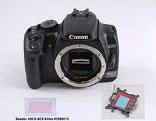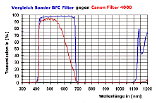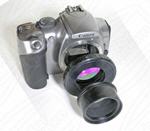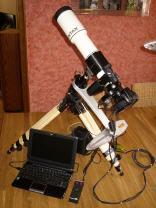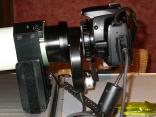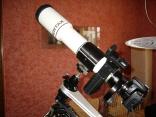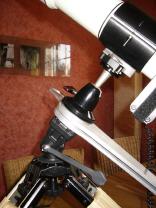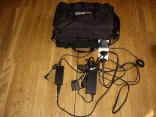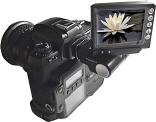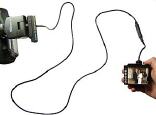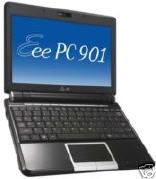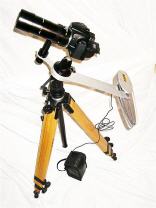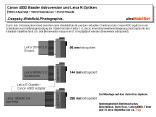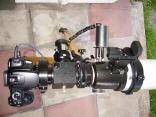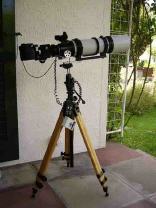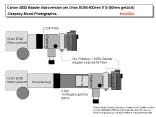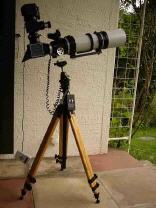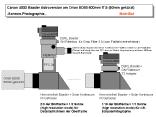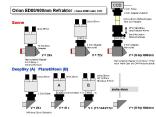Canon400D/Visuell Mobilesets
The original Canon 400D is the basement of my mobile photography. It was modified by Baader Planetarium germany into an astro version. The original front filter, together with the anti-aliasing foil had been replaced by a special BFR filter (about 0.5mm thin), leaving the piezo cleaning system uneffected. The filter characteristics are shown on the next picture.
The BFR filter allows a higher transmission of the important H-alpha line, keeping the exposure times shorter. Together with the removal of the anti-aliasing foil it improves the overall resolution/sharpness of the setup.
The picture shows a comparison of the original filter to the noval BFR version.
In order to protect the internal chip from dust, the Canon body is additionally equipped with an Astronomik clear clip-filter. The
Baader DSLR-T- Ring is empty and allows the adaption to the T2.
This Canon-Astro-Unit is used for all of the following setups at the modified ED80.
--------------------------------------------------------------------------------------------------
The Pentax 75 refractor is my favored telescope during the excursions. The highly corrected optic (over a wide field 60x45mm), makes the Pentax 75/500mm refractor suitable even for large format CCD astrofotographie. The photosetup is equipped with the Canon 400D (astroversion), an electric focuser and L-RGB Atik filterwheel. A Mini-Laptop with MaximDL5 allows the fully automated capturing of pictures. One USB Hub links the electric focuser (USB Focus Motor Controller, Shoestring Shoestring ), the Atik filterwheel (Atik USB upgrade box, Teleskope-Service-Ransburg), a long exposure cable seriell with USB adapter and the Canon USB cable to only one USB port at the Asus Mini-Laptop. The star-guiding is facilitated by the genial mount AstroTrac TT320 fixed to a short stativ, an Berlebach Report 7013 (here in wideangle configuration), very stable indeed...
The canon setup, brought into focus, leaves a distance of about 25mm over, measured inward from the the focal plane.
The more detailled view shows the connecting cables for long exposure mode, PC-MaximDL5 link, Atik filterwheel and electric focuser. The telescope received a small finder (TS-Ransburg). It improves the comfortable finding of objects in the photography setup.
The Manfrotto/connectors are very stiff mounted to the AstroTrac TT320, to the Linhof-3D-head and there is no movement at all. The Pentax tubeclamp was made by Beat Kohler AOK Swiss with various connection and mounting threads...
This portable powerstation is based on a small 12V Akku 7.2Ah and a 220V converter, both again linked to 220V/12V Canon camera and Asus-Mini-Laptop converters. The running time of the computer and Canon camera is extended up to 6.5 hours.
In order to look through the view finder, especially from difficult positions, I may use the Kaiser Zigview S2A (6240).
Next to the possibility to separat the screen box from the camera (shown on next picture), it consist of a complex timer and provides a live view throught the camera optical path. It includes additionally a motion detection system and allows the trigger releases. The digital view finder is made for the Canon 300D, 350D, 400D, Nikon D50, D70, D100 including:
- Lithium ion-accumulator, powercable, finder adapter, screen box cable, transceiver und stuff bag
– CCD-sensor 230.000 pixel
– Live-view, zoom, invert, flip
– variable cable lenght up to 31,5 m to separated screen box
– AV-port
– 2,5 " colordisplay
The display may be used separated from camera.
The powerful Asus minibook provides the controller software MaximDL5/DSLR software, which triggers the Canon400D astrocamera also in long exposure modes. Additionally it adds fantastic tools to handle and process the high resolution canon raw files. Of course with its 160 Gigabyte internal harddisk and 1GB Ram storage is not an issue...
--------------------------------------------------------------------------------------------------
The absolute minimum of equipment resembles a combination of lenses for brightfield fotografie together with the Canon-400D-Astroversion, without the DSLR-T- Ring. Highly corrected lenses, such as i.e. the Leica Apo-Telyt 3.4/180mm (CaF2 glass) may result in stunning pictures (see StuW article 5/2008 pages 98-102 or M71 AstroTrac
). The lenses are linked with a commercially available metal adapter Leica/Canon.
Everything is fixed on the genial AstroTrac mount and a Berlebach stative.
Three Leica lenses are used in combination with the Canon-400D-Astroversion:
- Elmarit 35/2.8 (56mm extrapolated)
- Summicron 90/2.0 (144mm extrapolated)
- ApoTelyt 180/3.4 (288mm extrapolated)
Camera, 3 lenses, AstroTrac/mount, Berlebach/stative and timer taken together 7kg...
--------------------------------------------------------------------------------------------------
The modified ED80 telescope (shortened by 50mm) enables various setups for deepsky/solar-photography and very comfortable binoviewer observations.
For the photography, the Canon-Astro-Unit is additionally linked to the Baader Flip-Mirror, parafocal equipped with an 12.5mm eyepiece, in order to optimize the focussing of the pictures. It is combined with a filterdraw (Gerd Neumann, germany), which allows the insertion of various filters into the light pathway, without reassembling the sensible setup in a dusty desert. Anyhow, such long optical pathways behind the focuser of the telescope, required a shortening of the telescope tube by 50mm, in order to reach the focus with the various setups.
The Deepsky setup with the shortened ED80 (AstroTrac not mounted).
The Canon-Astro-Unit can also be used in combination with the FFC projection eyepiece, but the Flipmirror/12.5mm eyepiece unit is due to the high magnification not suitable anymore. It serves rather as a pure spacer to reach the about 3x magnification.
The Canon-Astro-Unit in combination with the Herschel Wedge Solar Prism 2" as a brightfield solar observer.
Herschel Wedge Solar Prism 2" combinations with or without FFC eyepiece, leading to about 0.7 or 9/1 (field of view/ sun) ratios. The later one is used for the eclipse recording
Additional successfully tested combinations especially for visual obervations taking advantage of the Zeiss/Baader Widefield binoviewer.

